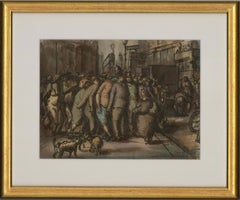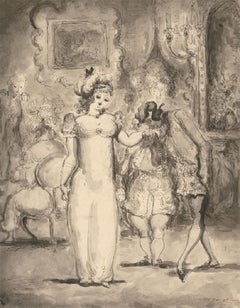Harold Hope Read Figurative Drawings and Watercolors
Harold Hope Read was born in Greenwich in 1881 and later lived in Lewisham in London, Brighton and Tunbridge Wells, where he passed away in 1959. During his years in Tunbridge Wells, where he moved to in the 1930s, Hope Read lived an avant-garde lifestyle with his live-in housekeeper, life model and mistress, who we know only as Hilda. Here the artist became known as the Bohemian of Tunbridge Wells and his work is now acknowledged as the precursor of Edward Ardizzone (1900–79). It is from Hilda, that the present collection of works originates, after being passed down through Hilda's family after her death. Hope Read’s involvement with his patron, Charles Lambert Rutherston and fellow artists William Orpen (1878–1931) and Sir William Rothenstein (1872–1945) has been credited for inspiring the series of paintings and drawings he titled High Life. In this series, Hope Read depicts the wealthy and famous clientele of his colleagues in a lavishly detailed drawing style. Through this style, he conveyed the opulence of the members of high-society he encountered, including their luxurious costumes and grand interiors. Hope Read regularly submitted works to the Royal Academy's Annual Exhibition and exhibited works at the Alpine Gallery, the New English Art Club, the Royal Institute of Painters in Watercolours and the National Society of British Artists.
20th Century Harold Hope Read Figurative Drawings and Watercolors
Watercolor
20th Century Harold Hope Read Figurative Drawings and Watercolors
Watercolor
20th Century Harold Hope Read Figurative Drawings and Watercolors
Watercolor
20th Century Harold Hope Read Figurative Drawings and Watercolors
Watercolor
20th Century Harold Hope Read Figurative Drawings and Watercolors
Watercolor
20th Century Harold Hope Read Figurative Drawings and Watercolors
Pen
20th Century Harold Hope Read Figurative Drawings and Watercolors
Watercolor
20th Century Harold Hope Read Figurative Drawings and Watercolors
Watercolor
Early 20th Century Impressionist Harold Hope Read Figurative Drawings and Watercolors
Watercolor, Pen, Ink
16th Century Old Masters Harold Hope Read Figurative Drawings and Watercolors
Ink, Gouache, Pen
1990s Contemporary Harold Hope Read Figurative Drawings and Watercolors
Ink, Pen, Acrylic
1990s Harold Hope Read Figurative Drawings and Watercolors
Pen, Acrylic, Ink
1990s Contemporary Harold Hope Read Figurative Drawings and Watercolors
Ink, Acrylic, Pen
1950s Modern Harold Hope Read Figurative Drawings and Watercolors
Paper, Watercolor
1930s American Modern Harold Hope Read Figurative Drawings and Watercolors
Paper, Watercolor, Pencil
1980s Harold Hope Read Figurative Drawings and Watercolors
Watercolor, Paper
16th Century Harold Hope Read Figurative Drawings and Watercolors
Pen, Watercolor
1940s Modern Harold Hope Read Figurative Drawings and Watercolors
Pen
1790s Romantic Harold Hope Read Figurative Drawings and Watercolors
Watercolor
1950s Modern Harold Hope Read Figurative Drawings and Watercolors
Paper, Watercolor, Gouache
Mid-20th Century Post-War Harold Hope Read Figurative Drawings and Watercolors
Watercolor
20th Century Harold Hope Read Figurative Drawings and Watercolors
Watercolor
20th Century Harold Hope Read Figurative Drawings and Watercolors
Watercolor
20th Century Harold Hope Read Figurative Drawings and Watercolors
Watercolor
20th Century Harold Hope Read Figurative Drawings and Watercolors
Pen
20th Century Harold Hope Read Figurative Drawings and Watercolors
Watercolor
20th Century Harold Hope Read Figurative Drawings and Watercolors
Watercolor
20th Century Harold Hope Read Figurative Drawings and Watercolors
Watercolor
20th Century Harold Hope Read Figurative Drawings and Watercolors
Watercolor
20th Century Harold Hope Read Figurative Drawings and Watercolors
Watercolor
20th Century Harold Hope Read Figurative Drawings and Watercolors
Watercolor
20th Century Harold Hope Read Figurative Drawings and Watercolors
Pen
20th Century Harold Hope Read Figurative Drawings and Watercolors
Watercolor









